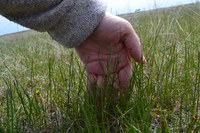Plan for delayed grazing season
(Click the image below to view a high-resolution image that can be downloaded)
A combination of fall drought and a delayed spring due to colder than normal temperatures are expected to cause significant delays in grass development and growth this spring.
Air temperature in the spring is the main environmental factor that determines the rate of grass development.
Miranda Meehan, North Dakota State University Extension livestock environmental stewardship specialist, explains that each leaf produced on a stem requires a specific amount of accumulated heat, or heat units. The temperature when plants initiate development, the base temperature, is 32 degrees Fahrenheit for cool-season grasses and 40 degrees Fahrenheit for warm-season grasses. The temperature or heat units that a plant needs to accumulate to produce a leaf can be expressed as growing degree days (GDD).
Perennial grasses start to accumulate growing degree days the first day after March 15 that the average daily air temperature exceeds 32 degrees for five consecutive days. The number of GDD needed to reach grazing readiness varies between grass species from 443 GDD for crested wheatgrass to over 1,000 GDD for most native species. Search online for “NDSU Extension Determining Grazing Readiness” for more information.
On average, cool-season grasses begin accumulating GDD on March 24 near Bismarck and March 30 near Jamestown. This spring, both locations did not start accumulating GDD until April 13. In addition to being delayed, GDD are accumulating slowly due to cooler than average temperatures, which are expected to remain below average in May.
Grazing readiness is the developmental stage where the plant is able to recover from the stress of grazing the previous year and produce sufficient levels of water-soluble carbohydrates (food) to replenish the roots. Grazing readiness for most domesticated pastures, such as crested wheatgrass and brome grass, is at the 3-leaf stage; whereas, grazing readiness for most native range grasses is the 3 1/2-leaf stage.
All cool-season grasses, which are the dominant grasses in North Dakota, initiate growth from a tiller that was established the previous growing season. However, drought stress during the fall of 2022 resulted in poor tiller development. Grazing management in the fall may have caused tillers to die. Poor tiller development and tiller death last fall are expected to delay development an additional one to two weeks this spring.
Pastures that have had tiller loss must be given adequate time to recover. Grazing too early in the spring can result in decreased total forage production for the entire grazing season.
“You may sacrifice 45% to 60% of forage production for the year by grazing too early,” says Kevin Sedivec, NDSU Extension rangeland management specialist and interim director of the NDSU Central Grasslands Extension Center. “The general rule to consider when grazing rangelands is for every day you graze in early May, you lose three days of grazing at the end of the grazing season. For every day you graze in the middle of May, you lose two days of grazing at the end of the grazing season.”
Grazing too early will reduce plant vigor, thin existing stands, lower total forage production, and increase disease, insect and weed infestations. Pastures and range damaged by grazing too early and/or severe overgrazing may take several years of deferment or even rest before the stand regains productivity.
A loss of forage production due to grazing prior to grazing readiness will reduce the recommended stocking rate and/or animal performance.
Due to the combination of cool temperatures and drought stress, ranchers should expect delays of approximately four weeks in grazing readiness this spring and manage accordingly. This would include avoiding grazing native range until grazing readiness has been achieved.
Strategies to avoid grazing native range prior to grazing readiness include:
- Grazing domesticated grass pastures, such as crested wheatgrass and smooth brome, in May. This year, domesticated pastures may not reach grazing readiness until mid-May.
- Providing supplemental forage to livestock on domesticated pasture or hay land. However, be careful not to graze your hay lands too early, too short or if muddy, as the stand will be dramatically reduced in forage production due to reduced vigor and plant damage.
- Using winter annuals that were established last fall for early spring grazing or hay.
- Continuing dry lot feeding in May.
“While it may be tempting to start grazing early due to a lack of forage resources, it can have long-term impacts on forage production,” says Meehan. “Remember, it takes grass leaves to replenish the root food reserves needed to grow grass. Early spring grazing, especially following a drought, can be costly in terms of total forage production during the entire grazing season.”
NDSU Agriculture Communication – April 28, 2023
Source: Miranda Meehan, 701-231-7683, miranda.meehan@ndsu.edu
Source: Kevin Sedivec, 701-231-7647, kevin.sedivec@ndsu.edu
Editor: Elizabeth Cronin, 701-231-7881, elizabeth.cronin@ndsu.edu


